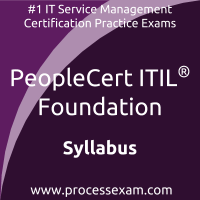 To achieve the professional designation of PeopleCert ITIL Foundation from the PeopleCert, candidates must clear the ITIL Foundation Exam with the minimum cut-off score. For those who wish to pass the PeopleCert ITIL Foundation certification exam with good percentage, please take a look at the following reference document detailing what should be included in PeopleCert ITIL Foundation Exam preparation.
To achieve the professional designation of PeopleCert ITIL Foundation from the PeopleCert, candidates must clear the ITIL Foundation Exam with the minimum cut-off score. For those who wish to pass the PeopleCert ITIL Foundation certification exam with good percentage, please take a look at the following reference document detailing what should be included in PeopleCert ITIL Foundation Exam preparation.
The PeopleCert ITIL Foundation Exam Summary, Body of Knowledge (BOK), Sample Question Bank and Practice Exam provide the basis for the real PeopleCert ITIL Foundation Certification - IT Service Management exam. We have designed these resources to help you get ready to take PeopleCert ITIL Foundation exam. If you have made the decision to become a certified professional, we suggest you take authorized training and prepare with our online premium PeopleCert ITIL Foundation Practice Exam to achieve the best result.
PeopleCert ITIL Foundation Exam Summary:
| Exam Name | PeopleCert ITIL Foundation |
| Exam Code | ITIL Foundation |
| Exam Fee | USD $363 |
| Exam Duration | 60 Minutes |
| Number of Questions | 40 |
| Passing Score | 26 / 40 |
| Format | Multiple Choice Questions |
| Books / Trainings | Offline Training |
| Schedule Exam | PeopleCert |
| Sample Questions | PeopleCert ITIL Foundation Exam Sample Questions and Answers |
| Practice Exam | PeopleCert ITIL Foundation Certification - IT Service Management Practice Test |
PeopleCert ITIL Foundation Syllabus Topics:
| Service management as a practice |
- Describe the concept of best practices in the public domain - Describe and explain why ITIL is successful - Define and explain the concept of a service - Define and explain the concept of internal and external customers - Define and explain the concept of internal and external services - Define and explain the concept of service management - Define and explain the concept of IT service management - Define and explain the concept of stakeholders in service management - Define processes and functions - Explain the process model and the characteristics of processes |
| The ITIL service lifecycle |
- Describe the structure of the ITIL service lifecycle - Account for the purpose, objectives and scope of service strategy - Briefly explain what value service strategy provides to the business - Account for the purpose, objectives and scope of service design - Briefly explain what value service design provides to the business - Account for the purpose, objectives and scope of service transition - Briefly explain what value service transition provides to the business - Account for the purpose, objectives and scope of service operation - Briefly explain what value service operation provides to the business - Account for the main purpose, objectives and scope of continual service improvement - Briefly explain what value continual service improvement provides to the business |
| Generic concepts and definitions |
- Utility and warranty - Assets, resources and capabilities - Service portfolio - Service catalogue - Governance - Business case - Risk management - Service provider - Supplier - Service level agreement - Operational level agreement - Underpinning contract - Service design package - Availability - Service knowledge management system (SKMS) - Configuration item (CI) - Configuration management system - Definitive media library (DML) - Change - Change types (standard, emergency and normal) - Event - Alert - Incident - Impact, urgency and priority - Service request - Problem - Workaround - Known error - Known error database (KEDB) - The role of communication in service operation - Release policy - Types of services - Change proposals - CSI register - Outcomes - Patterns of business activity - Customers and users - The Deming Cycle (plan, do, check, act) |
| Key principles and models |
Service strategy Service design
Continual service improvement
|
| Processes |
Service strategy State the purpose, objectives and scope for: - Service portfolio management
- Financial management for IT services
- Business relationship management Service design
State the purpose, objectives and scope for:
- Information security management (ISM)
- Supplier management
- Capacity management
- IT service continuity management
- Design coordination Service transition
State the purpose, objectives and scope for:
- Knowledge management
- Service asset and configuration management (SACM) Service operation State the purpose, objectives and scope for: Continual service improvement |
| Functions |
- Explain the role, objectives and organizational structures for
- State the role and objectives of
|
| Roles |
- Account for the role and the responsibilities of the
- Recognize the responsible, accountable, consulted, informed (RACI) responsibility model and explain its role in determining organizational structure. |
| Technology and architecture | - Understand how service automation assists with expediting service management processes |
| Competence and training |
- Competence and skills for service management - Competence and skills framework - Training |
| PeopleCert |
